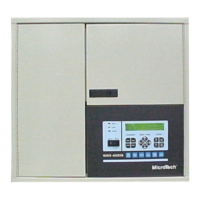OM 200MICRO 39
2 Evap Flow=xxxxgpm 1 Evaporator Water Flow at Alarm
3 Cond Flow=xxxxgpm 1 Condenser Water Flow at Alarm
Follow the above sequence to view the alarm menu 29-35 (Alarm Buffers #2-#8).
Press the "NEXT MENU" key and menu 36 (Alarm Output) will be displayed. Menu 36 has one
screen. This menu is password protected and requires the operator password. Menu 36 controls how
the alarms are reported through the alarm relay. The alarm relay is the interface to most building
automation systems or alarm device such as a bell or light.
Alarms are categorized into three different types. The alarms are defined as warnings, problems and
faults. A warning is a pre-alarm condition and an indication of a potential problem. Problems are
alarms that the MicroTech will cause a control modifications in an attempt to correct the problem.
Faults are alarms that cause an immediate system shutdown to protect the chiller and its components.
Menu 36 controls the reporting of these alarms via the alarm relay. Use this menu to have only the
alarms report that are necessary for your system.
Menu 36, Alarm Output
Screen Line Display Field Range Extended Name
Open
Alarm-Normal=Open 1
Close
Fast
Slow
Close
1
Problems=Fast 2
Open
Fast
Comm Loss=Slow 1
Slow
Fast
Slow
Close
2
Faults=Close 2
Open
Fast
Slow
Close
1
3 Warnings=Slow 1
Open
Alarm Reporting and Control of
Alarm Relay
Alarm-Normal= This value defines how the alarm contact will be in its normal (non alarm) position.
Normally open or normally closed. All alarms as they report will cause the alarm output to close or
open depending on this setting.
Problems= This value will define how problems will report (open/close) or how (fast/slow) the
reporting will occur. Only one can be selected. If fast/slow is selected the alarm contact logic will
follow the 'Alarm-Normal' value selected. Problem alarms are self-clearing but will be recorded into the
alarm buffers. Problems are defined as conditions where the MicroTech will try corrective actions to
avoid unit shutdown. Example, high head pressure. The MicroTech would unload the compressor to
a point where the head pressure was in an acceptable range.
Comm Loss= This value must be set if a network exists. This value will define how the 'Com Loss' will
report (open/close) or how (fast/slow) the reporting will occur. Only one can be selected. If fast/slow
is selected the alarm contact logic will follow the 'Alarm Normal' value selected.
Faults= This value will define how faults will report (open/close) or how (fast/slow) the reporting will
occur. Only one can be selected. If fast/slow is selected the alarm contact logic will follow the 'Alarm
Normal' value selected. Fault alarms require manual clearing and will cause immediate shutdown of the
unit. Faults should be investigated before clearing and allowing the unit to restart.
Warnings= This value will define how warnings will report (open/close) or how (fast/slow) the
reporting will occur. Only one can be selected. If fast/slow is selected the alarm contact logic will
follow the 'Alarm-Normal' value selected. Warning alarms are self-clearing but will be recorded into
the alarm buffers.
Press the "NEXT MENU" key and menu 37 (Message Board) will be displayed. Menu 37 has one
screen. This menu allows a technician to post a message via a computer. A message could be posted
by a remote computer using the modem.

